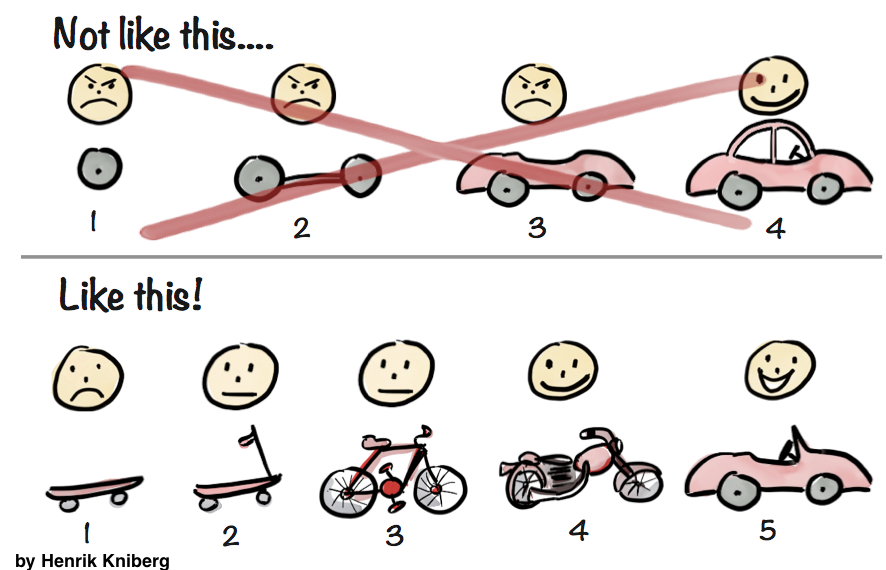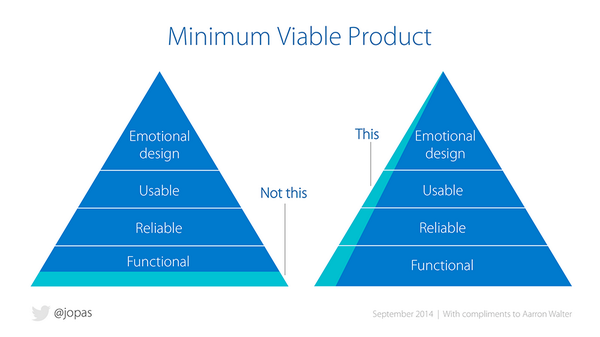Regan Davis
VP of Product Management
Jellyvision

Makers of ALEX, an interactive conversation for explaining HR and benefits to employees
Clients include Facebook, Disney, IBM, & HP
Previously VP of Product at info.com & Zenya
Everything is awesome

So many fantastic ideas to build
Sadly, none of them is a time machine
Waterfall
Everything is locked in up-front
Teams spend months designing, architecting, developing
Right before completion, pieces are put together and tested
Agile
Plan enough to do meaningful work, light planning for far off vision stuff
Short, repeated releases that are tested each time
Feedback from the customer throughout, so you can change the plan as needed
At the very end, it’s presented to the customer, who of course, loves it and says it’s exactly what they always wanted.
How does Agile help?
- Breaking a vision statement into small chunks
- Scope (i.e., Features) is what's flexible
- Testing happens in each cycle, instead of at the end
The goal is not to do as many tasks as possible. The goal is to have as great an impact as possible by doing as few tasks as possible.
- Agile Manifesto Principles
Scrum
Good for teams working toward milestones and deliverables
Timeframe and effort based
Kanban
Good for teams without distinct deadlines (Ops, e.g.)
Issue count based
Why
Iterate?


scrum
Roles

Product owner
Development Team
Scrum Master
Responsible for ensuring process is understood and enacted
Exists to protect the development team and the process
Wait, what aboutme?

Vision
Roadmap
Release
Sprint
Day
yearly or more
biannual
quarterly
bi-weekly to monthly
daily
Five levels of Agile planning
The
Backlog

The backlog
an ordered list of everything that might be needed for the product
(IS EVERYTHING)
User Story
a plain English, first person description of a feature
"As an [Email User], I want to [Archive Messages] so that [my Inbox isn't crowded.]"
Refine and Break Up as You Go
As A User...
User Story
As a user who chose an HDHP medical plan, I want to see my tax savings with an HSA, so that I can contribute to an HSA.
Acceptance Criteria
- Pulls estimated OOP costs from medical recommender
- Applies federal tax + FICA tax % (if not asked, use 19.65% average)
- Shows $ savings from contributing to HSA (OOP-tax%), and breaks OOP costs contribution by paycheck
- Ask to contribute. Options: "Yes", "I'm not ready yet"
- If "Yes", apply to plan selection
- If "I'm not ready yet", Send to Tax Savings module
Good USER STORIES require investment
- Independent
- Negotiable
- Valuable
- Estimable
- Small
- Testable
OH YEAH It's An Estimate pArty!

Humans are terrible estimators
estimate effort
- No assumption of accuracy
- Fewer options, like simple numbers or T-Shirt Sizes
- Easier to compare to stuff you've done before
Instead of estimating hours,
Story Points
1, 2, 3, 5, 8, 13, 20
A really rough numerical scale for estimating effort on User Stories
Numbers get wider apart the more effort something takes to accept that stuff takes longer
Bigger items need to get broken down into smaller chunks
Developers only
Only developers get to estimate how much effort something is.
- If I'm not actually building it, I don't get to tell you it's "so simple, just do it, just do it, it's easy"
- All developers should agree on the estimates
- Effort includes all the steps to reach "done"
- Development
- Local Testing
- Code Review
- Quality Assurance
- User Acceptance Testing
Death to All time estimates!
Yes and No.
Some places still prefer hour-based estimates
Hour estimates can still be good to break down components of a Story in Sprint Planning

The
sprint

What's in a sprint?
-
Sprint Planning
-
Daily Scrums
-
the development work
-
Sprint Review
-
Sprint Retrospective
Sprint planning
A meeting before each new sprint
What can be delivered this sprint?
Product Owner discusses objective and backlog items that would achieve it
How will we get it done?
Development team forecasts what it can do in the upcoming sprint
Break down stories into sub-tasks of no more than a day or two for the first things you plan to tackle
Daily Scrums
A max 15-minute daily meeting for dev team and Product Owner
Three questions to answer:
- What did I do yesterday?
- What will I do today?
- Do I see any impediment or blocker?
Often followed by more detailed discussions amongst team members to adapt or re-plan
Sprint Review
Informal at the end of the sprint
Includes dev team, product owner, stakeholders
- Explain what has been done and not done
- Demo the work that is done, answer questions
- PO discusses current backlog, perhaps rough projections
- Entire group collaborates on most valuable to do next
Result is a revised backlog to help plan the next sprint
Retrospective
Before next Sprint Planning
Includes dev team, product owner, scrum master
Meant for team to provide self feedback and establish process improvements
so many
Meetings!

It sounds much worse than it is.
Focus is talking with each other during development, not about the number of meetings you have.
Questions?
